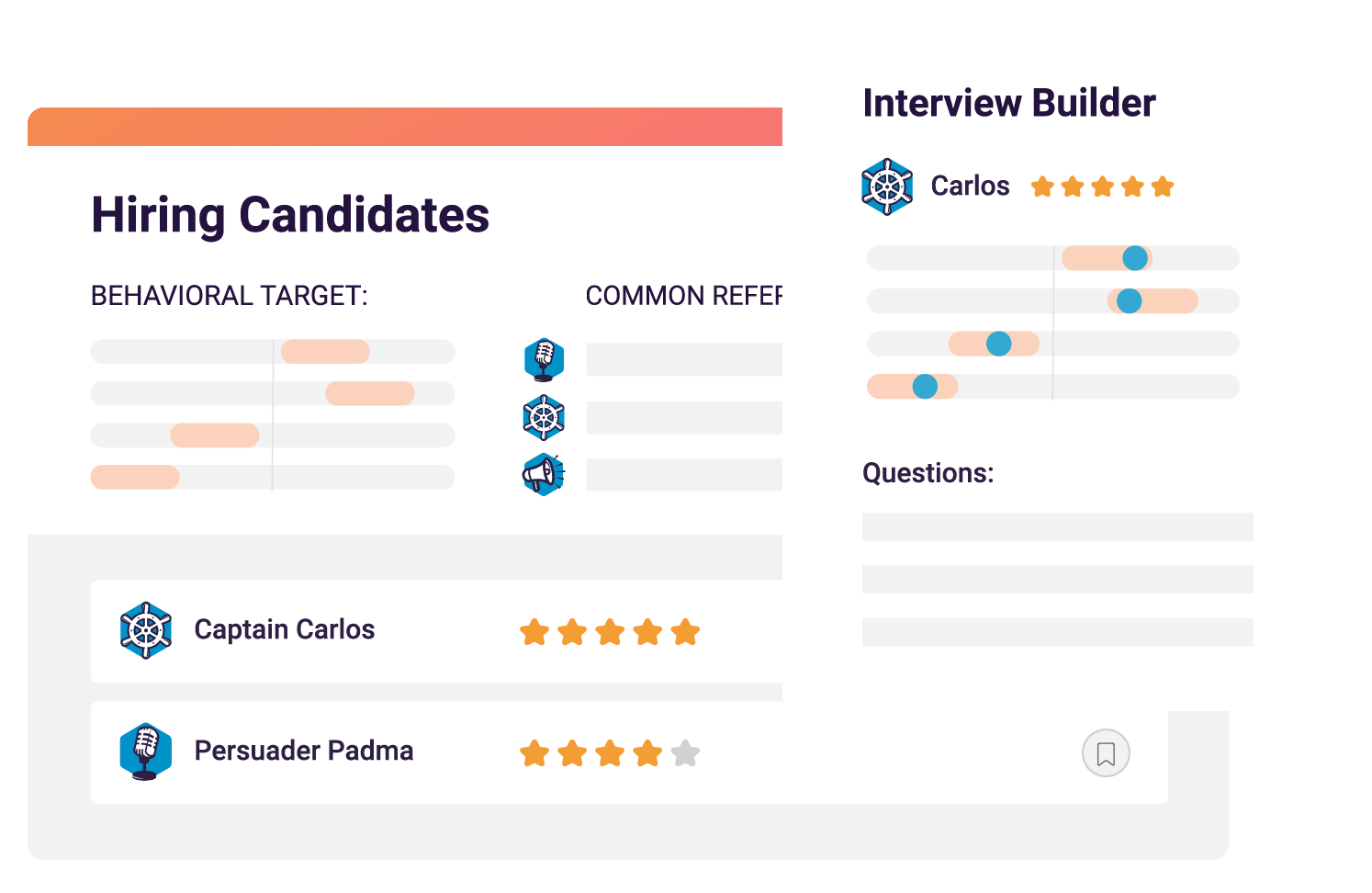A behind-the-scenes look at how great hiring really happens
Bragging time.
The Predictive Index® was acquired by new owners and started putting a new management team in place in late 2014. Since then, we’ve:
- Grown revenue 30% year-over-year on average
- Increased client count from ~4,700 to ~7,300
- Gone from 34 to 160 full-time employees
- Grown our Certified Partner Network by 300%
- Raised $50 million from General Catalyst, a top-tier private equity company
- Been named to Glassdoor’s Employees’ Choice list, Inc.’s Best Places to Work list, and Boston Business Journal’s Best Places to Work list
OK, so why the bragging? Because I think it’s important to establish that PI has had a lot of success over the past four years. PI has some real bona fides when it comes to building a great company. And much of that success points back to one pillar of excellence we’ve established here: hiring great people.
Other resources that might interest you:
- Let’s get smart about hiring
- Six reasons to utilize personality tests during the hiring process
- 5 ways a strategic HR plan will help you earn a seat at the table
8 recruiting tips for successful hiring
As a hiring manager, I’ve been fortunate enough to have worked at some great companies with great people through the years. None of them hires as well as PI.
I wanted to share some of our secret sauce when it comes to recruiting people who will continue to help our company thrive—and explain it all from a hiring manager’s perspective. Below, I’ve deconstructed the steps that will lead to your hiring success.
1. Continuously build your candidate pipeline.
Given that we’ve been in a constant state of hiring over the past four-plus years, we’ve found it necessary to constantly build the pipeline of potential job candidates. Some keys to our success on this front:
An internal recruitment team
Since 2017, we’ve gone from zero full-time dedicated recruiters to three dedicated recruiters. This has given us the horsepower to run a top-tier recruitment operation.
A compelling careers section on the website
Not only do we list all open jobs on the careers section of our website, but we produce videos about our culture and the process so candidates can know what to expect from us. We also highlight the personal journeys of some of our employees, describe the benefits of working at PI, and link to our Culture Code overview.
Hiring managers with a recruiting mentality
So many hiring managers consider recruitment to be the purview of the recruiting team, and they think their job is to show up for interviews and pass judgment on whatever candidate recruitment hands to them. They’ve got a “not my job, not my prob” mentality when it comes to finding great candidates. They are 100% wrong! Nothing you do as a manager is more important than hiring the right people onto your team. Actively recruiting passive candidates is a shared job. Hiring managers need to pitch highly-coveted candidates on the dream of working at the company. I even record custom outreach videos using Wistia’s Soapbox tool.

Recruiting events
One of the challenges we face from a recruiting standpoint is that we’re headquartered in a suburb (Westwood, MA) that quite a few Bostonians couldn’t point to on a map. So twice in the past year, we’ve put on recruitment events in Boston. We invite potential employees to come mingle with us over drinks and food. While there, we sell them on the benefits of working outside the city (free parking is a major bonus).
A generous employee referral program
Our biggest source of hires is our existing employee base. We offer a $5,000 referral bonus for new hires who are still with the company after three months.) For roles that are especially difficult to fill, we offer a $10,000 referral bonus.
An amazing work environment
This deserves more than a subheader in an article, and you can learn more about our executive team’s philosophy on employee experience right here. As I mentioned earlier, PI has landed spots on several prestigious Best Places to Work lists. We’ve seen first-hand that creating this kind of reputation drastically increases the number of applicants per job. I recently posted a marketing coordinator position and received 220 applications.
2. Be diligent about defining the job.
Once a position has been approved for hiring (by our CFO), we always ensure that we have properly scoped and defined the job. At PI, we create job descriptions, and we also fill out a document we call a New Hire Needs Form. The NHNF (here’s our template) forces managers to articulate what will make a new hire successful in the new role. This step helps us sharpen our focus in terms of the kind of person we’re looking to hire.
3. Set a Job Target.
Not surprisingly, we’re religious about using psychometric data here at PI. As a general rule, before talking to potential candidates, we create a Job Target, which helps us know what we’re looking for in terms of behavioral pattern, as well as cognitive ability.

4. Gather psychometric “people” data.
As we start to accept applications—as well as work to attract passive candidates—we always ask candidates to take a behavioral assessment. While this is massively important to us as a data point, it’s also a win for the candidate. We share the behavioral assessment reports with job candidates, which they greatly appreciate. It also helps us explain to them how they might be a great (or not-so-great) fit for the role at hand.
Not long ago, I had the chance to chat with Jim Koch, the founder of Boston Beer Company. He’s been using PI for 30+ years and what he said about using behavioral data to help get people into roles where they’ll be successful rang true for me. Check it out:
5. Do phone screens.
Prior to bringing a candidate in for the onsite interview, both the hiring manager and recruiter talk to the candidate. Sometimes this is done in person in a casual way (e.g., meeting over coffee) but generally it’s done over the phone. This step of the screening process is critical.
Here’s what we seek to accomplish during the conversation:
Determine whether behavioral gaps will be problematic: By the time we’ve had our first conversation with the candidate, we understand how their behavioral pattern aligns with the Job Target. Here’s a real-life example of how our Job Target for a role matched up with a candidate’s behavioral pattern:
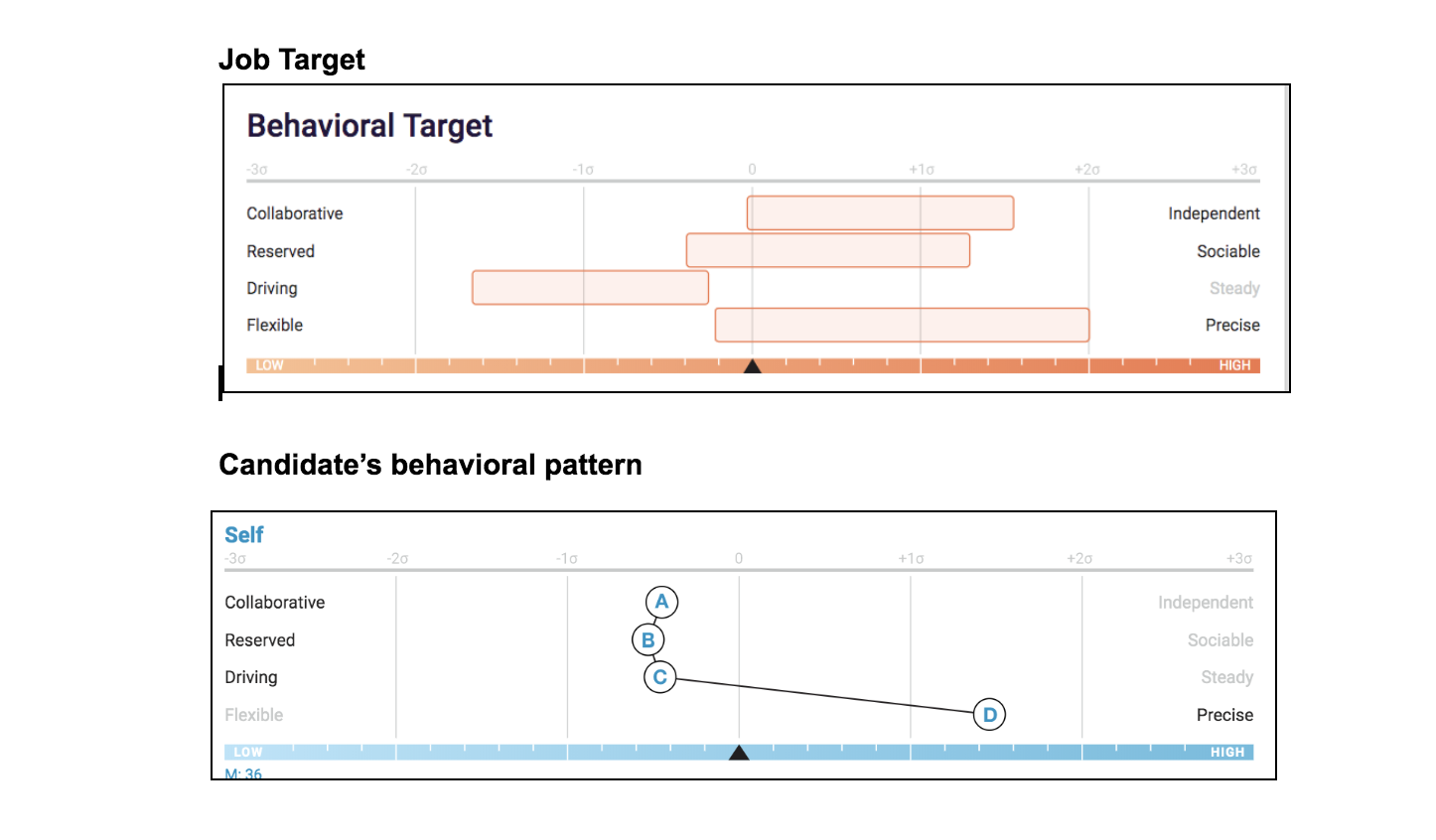
You can see that the candidate’s A factor (we call this the Dominance factor) doesn’t quite match the Job Target. Having this insight allows the hiring manager to probe into what might be challenge areas if the candidate ends up in the job. You’ll want to determine whether this gap will be a problem. You should also ask questions to confirm behavioral job fit. Can you hire someone whose pattern doesn’t perfectly align with the Job Target? Sure. It’s a guide, not an absolute rule.
Get to know them better: Aside from asking questions about behavioral fit, hiring managers at PI use the telephone interview as an opportunity to ask questions to get to know the person better. To ensure a level playing field for all candidates, we like to ask how they would go about solving a problem; go beyond basic background questions that favor certain people; understand people’s learning styles; and discuss their approach to and philosophies about work.
Be consistent: I’ve found that it’s a best practice to ask the same setup questions of each person I speak to; again, it’s about giving each candidate a level playing field. There’s a lot of evidence that structured interviews lead to better hiring. While we normally think about structured interviews in the context of in-person interviews, there’s utility in asking candidates consistent questions during phone screens too so you can make apples-to-apples comparisons when choosing who to move forward in the process.
Join 10,000 companies solving the most complex people problems with PI.
Hire the right people, inspire their best work, design dream teams, and sustain engagement for the long haul.
Here’s an example of a phone screen template I created for a role I filled. I would literally clone that Google Doc template for each new candidate and use the cloned, renamed version to take notes about our conversations. (You’ll notice that I not only have questions for candidates, but I also have my own talking points that I want to be sure to cover. After all, recruiting is as much about selling and educating as it is about evaluating.)
6. Hold out for the right person.
Simply put, we’re uncompromising about who we hire. There are some roles we’ve had open for over a year and haven’t filled. Is it painful? Yes. Does it cause internal stress and even friction? Yup. Are we unreasonably selective? Maybe. But if you’re going to pick one area where you’re going to be uncompromising, this is it.
7. Have the in-person “Super Day” interview.
This is where things start to get real. At PI, we invite final candidates in for “Super Days,” which consist of a series of in-person conversations with various employees the candidate would be working with most—managers and individual contributors. This is our attempt to get all major stakeholders face time with candidates. We try (not always successfully) to keep these Super Days to three hours or less, so often people team up on interviews.
In addition to the conversations with stakeholders, we always include a special interviewer who focuses on our cultural values (we call them THREADS). We have dedicated employee volunteers who do these THREADS interviews, and as a general rule, the person who conducts the THREADS interview comes from a department other than the one doing the hiring. This is because it’s important to determine candidate culture fit. You want someone who aligns with your core values—or adds to your culture.
Here are a few exceedingly helpful (and sometimes painful) lessons I’ve learned about Super Days and how to make them as productive as possible:
Decide whether you’re willing to make a reputational bet on the person.
By the time someone comes in for a Super Day, you (as the hiring manager) should feel real conviction around the candidate. One mindset to have is that you’re betting your reputation on having multiple people spend time with this candidate.
One of the more mortifying experiences of my career came when I brought a candidate I didn’t have total belief in onsite. His first interview was with my boss, Drew, and the candidate had another three or four people scheduled to talk to after that. Ten minutes after starting his chat with Drew, I saw Drew leave the interview room and escort the candidate out of the building. I was shocked. Drew came back and simply said, “It was clear he wasn’t a fit, and I didn’t want to waste his time or ours.” He was 100% right. Lesson learned. I’ve never again brought a candidate in for a Super Day that I wasn’t willing to make a reputational bet on.

Do assignments as a precursor to Super Day.
I am a huge fan of giving candidate assignments (some call these “skills assessments”). I have a blanket policy that I won’t hire anyone without some kind of assignment as part of the process. It gives both parties a window into how the other party works. It’s best to give assignments to people before the Super Day, not after. The Super Day is time-consuming for candidates, and it’s time-consuming for the interviewers; it’s an expensive meeting. As such, it should be the last hurdle in the process, and that’s why the assignment should come first. If you’re not happy with how the assignment goes, it’s better to spare the candidate the day off from work to come onsite.
Get salary on the table prior to the Super Day.
There’s a theme here. Get all the potential deal breakers out of the way before you spend gobs of your team’s and the candidate’s time by bringing candidates in. Having someone come in for fantastic Super Day and then finding out they’d require 50% more in salary than you can give is a recipe for personal heartache and a sour taste in a candidate’s mouth. And there’s no reason for it. Of course, salary can be an uncomfortable topic. But it’s a topic you’re going to have to broach at some point, so get it out of the way early on. (And if you’re as lucky as we are at PI, your recruiters deal with the compensation discussion for you.)
Have the cold, hard reality conversations before the Super Day.
Here’s something I’ve learned about great recruiters and hiring managers. They sell the dream, but they don’t sell a false bill of goods. They’re perfectly clear and upfront with candidates about what’s great—and what’s not-so-great about the situation they’re trying to lure someone into. Here’s how a sage friend of mine (and sales executive) put it:

“Asking someone to bet their careers on you and your job and your company is a big deal and a big ask. And here’s the truth of the matter: no organization is perfect. Every single company and every single job has its warts. Not letting candidates know about those warts is… well… just plain stupid. It’s not like they’re not going to find out!“
Prep your team.
You’ve spent a ton of time talking to this candidate, reviewing their LinkedIn profile with a fine-toothed comb, going back and forth with them on their assignment, sharing additional information as candidate questions arise. However, your team—the people whom the candidate will be meeting with when they come in—may not be looped in. But then you’re asking them to evaluate that candidate. And remember, the candidate is also evaluating the opportunity based on these conversations. It’s all too easy and too common for there to be a complete lack of preparation and game planning among the interviewing team.
Here’s how I set our team up for success. I create team interview prep sheets, and I distribute them to all members of the interview team. I provide the background on how the candidate got to this point in the process and give topical areas for each interviewer to focus on. These focus areas are critical because it ensures everyone is using their time in a valuable and efficient way and not having redundant conversations. Here’s a recent example of a real team interview prep sheet that I used for a Super Day.
It’s worth noting that in some cases, hiring managers at PI tell interviewers explicitly whether they’re assessing, selling, or both. During a Super Day earlier this week (more about this one later), I told our CEO that I just wanted him to sell—no evaluating necessary.
Coordinate behind the scenes.
Remember, by the time the candidates come to us on Super Day, my mindset is that I’m making a bet on the person. I’m basically an advocate for the candidate at this point, and I’m collecting information as quickly as possible. Like any other day, I’m juggling meetings and calls and tasks, but whenever I have slots of time during the candidate’s time at the office, I’m checking in with people who have talked to the candidate to get a quick pulse check on their impressions. Both managers and individual contributors get a chance to weigh in. If someone raises a concern, I’ll usher it over to someone who hasn’t interviewed the candidate yet for further vetting.
There’s lots of coordination between the hiring manager and the recruiter during this time as well. At PI, we always schedule the recruiter to be the last person the candidate talks to as a wrap-up to the day, and we aim to know whether we want to make an offer by the time that recruiter wrap-up meeting happens. That allows the recruiter to try to close the candidates if the hiring manager gives the nod, as well as unearth any lingering reservations from the candidate.
8. Move decisively if you decide to make a job offer.
While I’ve heard a lot of seasoned managers say they subscribe to a “hire slow, fire fast” philosophy, it’s a competitive job market, and once we’ve found the right person, we act swiftly.
In some cases, we’ll make a verbal offer during the Super Day (this is why all the behind-the-scenes scrambling is so critical). Often times, we’ll want to chat more about the candidate before making an offer. Or perhaps we’ll want to call references before making a verbal offer. Whatever the scenario, our philosophy is that if the Super Day goes well, we should move quickly.
An example of how it all comes together
Here’s a real-life scenario that unfolded over the past 48 hours. After going through steps 1-6 (selling PI to a passive candidate), we had that person in for a Super Day starting at 8 a.m. on Tuesday. Here was her Super Day schedule:
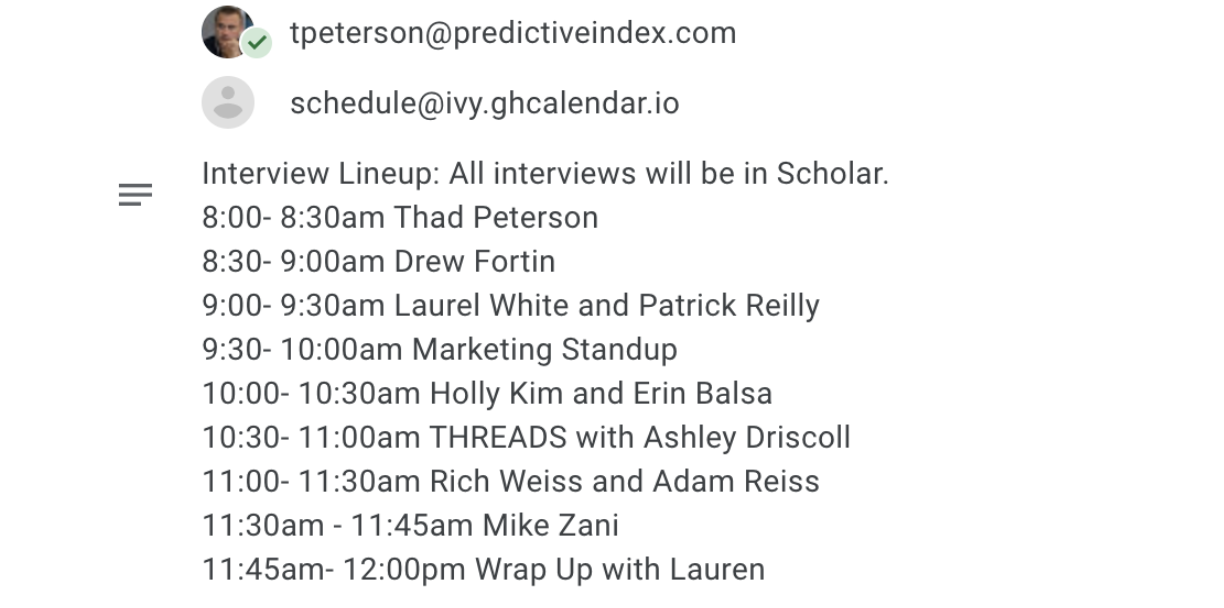
Here was the team interview prep sheet.
Morning of the in-person interview day
As you can see, it was a full day. I was checking in with interviewers throughout the day and keeping in continuous touch with Lauren (my recruiter on this job). By the end, we had a sense that we liked this candidate a lot. Lauren didn’t make an offer during the wrap-up, but she started the closing process. Lauren went a bit deeper on compensation with the candidate, uncovered the fact that the candidate had an annual bonus coming up at her existing employer, and talked loosely about what kind of time frame would work for a start date.
Afternoon of the in-person interview day
Lauren and I were able to connect for a few minutes in the mid-afternoon after the candidate left. We agreed things looked good but wanted to check in with a few references before making an offer. We agreed I’d handle the references (I’m a control freak during the recruitment process, so it was bound to go that way). I connected with the candidate at 6:00 p.m. and asked for references. She had two references confirmed and ready to talk by 6:45 p.m. (another great sign: both about her interest in the job and about her ability to quickly secure references). By later that evening, I had set up two reference calls for 10:30 a.m. and 11:00 a.m. on Wednesday (another good sign: two senior-level people responding at night and clearing their busy calendars for the next day to do reference calls).
Morning after the in-person interview day
Just like with the phone screens with the candidate, I prepared notes and questions for the reference calls. Both references came back glowing. Their stories matched one another—as well as the candidate’s in terms of her strengths (which were many) and her weaknesses (which were few). We had found a gem! I reached out to the candidate and set up a time for us to talk that afternoon.
Afternoon after the in-person interview day
On our call, I shared with her all the things our team liked about her. And I also shared with her what I thought her biggest challenge area would be (her behavioral profile is one that struggles with risk, and interviews and references all corroborated this but also gave me confidence that it’s a challenge she can rise to; we spoke about it openly and honestly).
After talking through these issues, I gave her a verbal offer, and she gave me a verbal acceptance. Yes! We talked through possible start dates and agreed that she’d start with our next new hire onboarding class.
To get the written offer out, I pinged Lauren over Slack (our online chat platform). Here’s that communication:
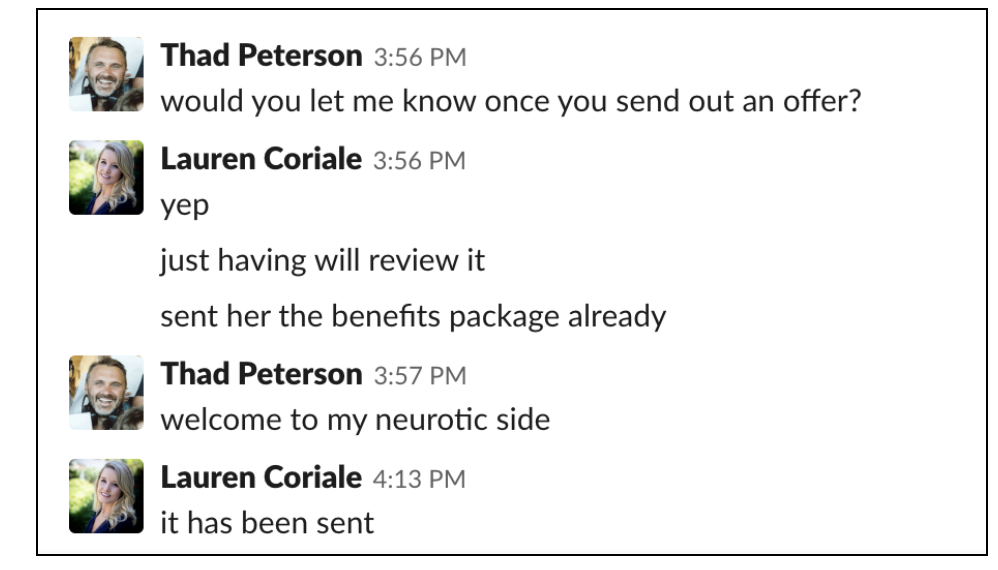
And then, later Wednesday night, the payoff email…
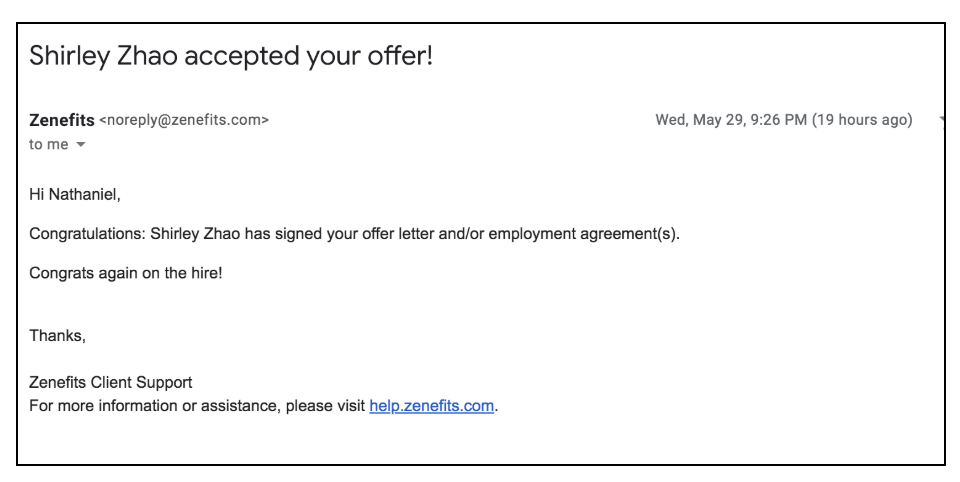
Note that the Super Day was on Tuesday morning, and the candidate signed her offer on Wednesday night. Part of great hiring is committing to moving expeditiously toward the end. And by the way, prepare for this to be time-consuming and a bit of an emotional roller coaster.
So there it is—a look behind the scenes at how hiring really happens at PI. I hope you can use some of these tips with the same success rate we’ve seen.
